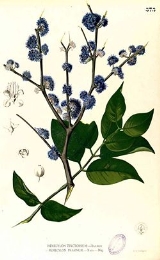
Memecylon edule
Encyclopedia
Memecylon edule is a small evergreen tree native to India, especially the Deccan Plateau
, including most of Karnataka
, Andhra Pradesh
, and parts of Tamil Nadu
. Common names include kaayam, delek bangas, delek air, miat, and nemaaru.
The tree grows on rocky soils and blooms once or twice per year. The fruit is about a centimeter long and green, turning red then black as it ripens. The tree has a thin bark, so it is sometimes also called nipis kulit or "thin-skinned" in Malay
. This tree is valued as an ornamental
and a source of wood for construction.
The leaves are thick and leathery. They contain glucoside
s, resin
s, colouring pigments
, gum
s, starch
es, and malic acid
. They are rich in aluminum. Yellow color dye can be extracted. Leaves and roots are used as a medicine for dysentery
and as an astringent
.
Deccan Plateau
The Deccan Plateau is a large plateau in India, making up the majority of the southern part of the country. It rises a hundred meters high in the north, rising further to more than a kilometers high in the south, forming a raised triangle nested within the familiar downward-pointing triangle of...
, including most of Karnataka
Karnataka
Karnataka , the land of the Kannadigas, is a state in South West India. It was created on 1 November 1956, with the passing of the States Reorganisation Act and this day is annually celebrated as Karnataka Rajyotsava...
, Andhra Pradesh
Andhra Pradesh
Andhra Pradesh , is one of the 28 states of India, situated on the southeastern coast of India. It is India's fourth largest state by area and fifth largest by population. Its capital and largest city by population is Hyderabad.The total GDP of Andhra Pradesh is $100 billion and is ranked third...
, and parts of Tamil Nadu
Tamil Nadu
Tamil Nadu is one of the 28 states of India. Its capital and largest city is Chennai. Tamil Nadu lies in the southernmost part of the Indian Peninsula and is bordered by the union territory of Pondicherry, and the states of Kerala, Karnataka, and Andhra Pradesh...
. Common names include kaayam, delek bangas, delek air, miat, and nemaaru.
The tree grows on rocky soils and blooms once or twice per year. The fruit is about a centimeter long and green, turning red then black as it ripens. The tree has a thin bark, so it is sometimes also called nipis kulit or "thin-skinned" in Malay
Malay language
Malay is a major language of the Austronesian family. It is the official language of Malaysia , Indonesia , Brunei and Singapore...
. This tree is valued as an ornamental
Ornamental plant
Ornamental plants are plants that are grown for decorative purposes in gardens and landscape design projects, as house plants, for cut flowers and specimen display...
and a source of wood for construction.
The leaves are thick and leathery. They contain glucoside
Glucoside
A glucoside is a glycoside that is derived from glucose. Glucosides are common in plants, but rare in animals. Glucose is produced when a glucoside is hydrolysed by purely chemical means, or decomposed by fermentation or enzymes....
s, resin
Resin
Resin in the most specific use of the term is a hydrocarbon secretion of many plants, particularly coniferous trees. Resins are valued for their chemical properties and associated uses, such as the production of varnishes, adhesives, and food glazing agents; as an important source of raw materials...
s, colouring pigments
Pigment
A pigment is a material that changes the color of reflected or transmitted light as the result of wavelength-selective absorption. This physical process differs from fluorescence, phosphorescence, and other forms of luminescence, in which a material emits light.Many materials selectively absorb...
, gum
Gum
-Natural gums:* Natural gum, any of a number of naturally occurring resinous materials in vegetative species* Gum anima* Gum arabic, used as food additive, adhesive et al.* Cassia gum* Dammar gum* Gellan gum* Guar gum* Kauri gum* Locust bean gum* Spruce gum...
s, starch
Starch
Starch or amylum is a carbohydrate consisting of a large number of glucose units joined together by glycosidic bonds. This polysaccharide is produced by all green plants as an energy store...
es, and malic acid
Malic acid
Malic acid is an organic compound with the formula HO2CCH2CHOHCO2H. It is a dicarboxylic acid which is made by all living organisms, contributes to the pleasantly sour taste of fruits, and is used as a food additive. Malic acid has two stereoisomeric forms , though only the L-isomer exists...
. They are rich in aluminum. Yellow color dye can be extracted. Leaves and roots are used as a medicine for dysentery
Dysentery
Dysentery is an inflammatory disorder of the intestine, especially of the colon, that results in severe diarrhea containing mucus and/or blood in the faeces with fever and abdominal pain. If left untreated, dysentery can be fatal.There are differences between dysentery and normal bloody diarrhoea...
and as an astringent
Astringent
An astringent substance is a chemical compound that tends to shrink or constrict body tissues, usually locally after topical medicinal application. The word "astringent" derives from Latin adstringere, meaning "to bind fast"...
.

